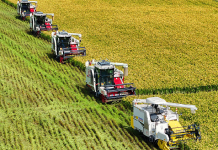ISLAMABAD: Pakistan has successfully achieved the desired results in the agriculture sector by following appropriate policies.
WealthPk quoting Federal Minister for National Food Security and Research Syed Fakhar Imam stated, Pakistan is generating an additional Rs400 billion (Rs118 billion from wheat, Rs136 billion from cotton, Rs46 billion from rice, Rs96 billion from sugarcane, and Rs3 billion from maize) for farmers this year.
Record production of rice and wheat is a good sign for the economy. Imam is also hopeful of a surge in the production of sugarcane and cotton this year. Cumulatively, these four crops will grow by 37 percent, WealthPK reported.
Owing to the wheat shortage the previous year, the government approved the import of duty-free three-million-ton wheat. However, in the current year, the crop production surged and reached 27.5 million tons with additional production of 2.2 million tons.
Pakistan spent almost $900 million on the import of the same amount of wheat in the previous year.
Rice production also surged in FY 2022 and reached 9 million tons. Domestic consumption of rice was 3.5 million tons in FY 2021. With a total available stock of 2.5 million tons from the previous year, Pakistan now has an export potential of 8 million tons. Imam said Pakistan had the potential to earn $4.5 billion by exporting rice, but currently, it stood at $2.1 billion.
By taking some more suitable steps, Pakistan can improve its production and exports to generate handsome revenue, WealthPK reported.
Fakhar Imam is expecting 9 million cotton bales compared to 7 million bales in the previous year. If the additional 2 million bales are exported, it would add $7 million to the foreign exchange.
Sugarcane production is expected to reach 89 million tons from 81 million tons in the previous year. One of the reasons for the expected increase in production is an increase in area from 1 million hectares to 1.2 million hectares in FY 2022.
According to the Pakistan Sugar Mills Association, the sugar industry contributes Rs484 billion (2.7 billion USD) to the GDP, Rs80 billion (452 million USD) to tax revenue, 500 million USD to the foreign exchange by exporting ethanol, and pays 350 billion (2 billion USD) to farmers.
The country has the potential to generate almost $3 billion by exporting sugar without subsidy, WealthPK reported.
According to the Pakistan Economic Survey 2020-21, the government has allocated Rs277 billion for the uplift of the agriculture sector under the National Agriculture Emergency Program (NAEP).
Under this program, 13 mega projects are under way. The government has also announced the Rabi Package of Rs5.4 billion to reduce the input cost for farmers. Moreover, the minimum support price has been increased from Rs1,400 to Rs1,800 to encourage farmers.
Under the above-mentioned program, the government gave Rs2,000 subsidy per acre on sesame, Rs1,000 subsidy per bag of cottonseed, Rs1,000 subsidy per bag of DAP fertilizer, 80 percent subsidy on the price of specific agricultural machinery, and Rs100,000 subsidies for tunnel farming to increase the production of fruit.
All subsidy amounts have been transferred through the Kisan Card which reduces the possibility of corruption. The Punjab government has introduced a loan program – Strengthening Market for Agriculture and Rural Transformation (SMART) – for five years (2018-23) with the collaboration of the World Bank (300 million USD) to end poverty and promote prosperity. -INP






